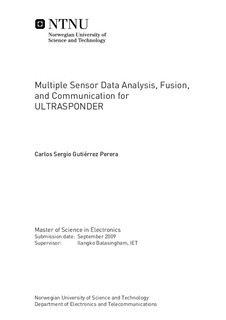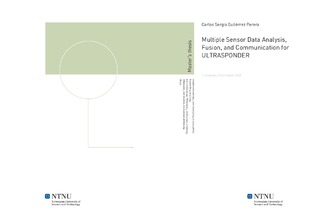| dc.description.abstract | This Thesis covers a part of the study comprised in the ULTRASPONDER (In vivo Ultrasonic Transponder System for Biomedical Applications) Project. The main area of interest is to study how to combine different signals which can imply an improvement onto the diagnostic information carried by the ECG records. It is believed that monitoring blood pressure inside the heart may give vital information to correctly diagnose and provide treatment for chronic heart failure patients. Moreover, heart rate variability analysis has proved to be one of the most important risk predictors in detecting ventricular tachycardias and fluttering. With this focus, the Thesis provides a solid background on cardiac anatomy and physiology, uncommon in many engineering texts, in order to understand the biological changes that affect the waveforms, for then moving to the performance of a theoretical and statistical study in order to find correlations, redundancies, or new information content in the signals intended to cohabit in the ULTRASPONDER control unit, namely, signals from the intra-cavity pressure sensors, ECG electrodes and other type of sensors, as well as heart rate time-series. Because this control unit, implanted underneath the patient's skin, must handle several different signals and transmit clinically relevant information in a power constraint manner to an external device, which may have much larger amount of resources, all signal processing performed in the context of the control unit must be kept under a reasonable limit that permits to efficiently extract information about the patient's health without decreasing the device's lifetime. We have implemented two time-domain QRS complexes detection systems, two simple beat classification algorithms based on beat-to-beat segmentation and template correlation, and some HRV measures as fundamental elements of ECG signal processing. Detection performance is analyzed from a critical point of view, considering several not so common parameters, such as Qalpha and MCC, which collect much more information than the usual sensitivity and predictivity assessments. A closed-loop DPCM system was chosen for the encoding and compression tasks, experiments showing its validity for ECG and blood pressure signals, although advising against its usage for HR time series. Compression performance is analyzed in terms of compression ratio attained and distorsion introduced. A novel measure called "compressibility quotient" (CQ) is presented as an indicator of the balance between theoretical compression limits marked by the sample entropy and actual compression obtained with a concrete scheme, in terms of the tradeoff CR-distorsion. A strong correlation between signal-to-noise ratio and CQ was found, implying that this measure might have some relevance for analyzing real compression possibilities under some quality criteria. The approaches followed in this Thesis, particularly regarding the theoretical study and data fusion comments, are valid for the ECG, blood pressure and heart rate signals considered, without detriment to be likewise applied to new signals that might become of interest in the future years. When new sensors are implemented to provide distinct signals, a theoretical study can include them to find out their usefulness and relation to the ones already considered. Data fusion should then be reviewed to assess the validity and convenience of the communication system for the new set of significant signals. | nb_NO |

